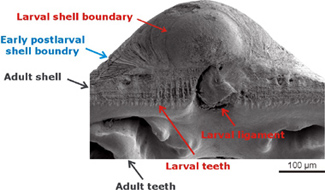A key to understand bivalve biodiversity and evolution

There are ca. 20.000 living species of bivalve molluscs, one of the oldest and evolutionary most successful classes of invertebrates. An ongoing research project at the Paleontology Area of the UAB Department of Geology deals with the question of how ontogeny and biodiversity evolved in these molluscs. The results can explain the existence of convergent traits in unrelated phylogenetic lineages.
There are ca. 20.000 living species of bivalve molluscs, one of the oldest and evolutionary most successful classes of invertebrates. An ongoing research project at the Paleontology Area of the UAB Department of Geology deals with the question of how ontogeny and biodiversity evolved in these molluscs. The results can explain the existence of convergent traits in unrelated phylogenetic lineages.
References
Malchus, N; Waren, A, Shell and hinge morphology of juvenile Limopsis (Bivalvia : Arcoida) implications for limopsid evolution, MARINE BIOLOGY RESEARCH, 1 (5): 350-364 NOV 2005.


